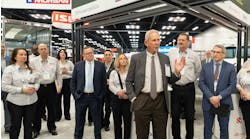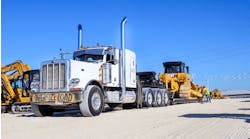SAN ANTONIO—Patrick Cooksey believes in the power of automated tire inflation.
The fleet maintenance manager for Hickory, North Carolina-based wholesale grocery distributor Merchants Distributors (MDI) has relied on the Meritor Tire Inflation System (MTIS) from Pressure Systems International (P.S.I.) to keep his company’s fleet of 815 refrigerated and dry van trailers moving product since 2016.
“Our drivers were experiencing a lot of flats on the side of the road, so we needed a system that could keep tires inflated because we didn’t have enough people to go out and check every tire on every trailer,” he explained.
The only problem, he says, is the system sometimes works too well.
“It keeps tires inflated,” he said. “The issue is that it will keep inflating tires even when they’re getting more impacts. We’ve pulled off tires with seven or eight nails in them, and when they have that many punctures so close together, they’re no longer usable. We can’t recap them. So we have to get tires off before that happens.”
No problem, insists Mike Niemeyer, P.S.I.'s director of strategic accounts. P.S.I. has a solution there, too: TireView Live analytics for monitoring tire pressures, wheel-end temperatures, and other data in real time. With TireView Live, fleet managers can pinpoint when each puncture occurs—and promptly schedule shop time.
View the media gallery for more from the P.S.I. plant tour.
Proven technology
No transportation technology has achieved 100% adoption in less than a decade, and most never accomplish that feat, said Dave Schaller, industry engagement director for the North American Council for Freight Efficiency, pointing to a 2019 fleet fuel study that showed adoption rates for different technologies were “all over the map” from 2003 to 2018. But inflation systems for trailer tires were near the top.
In fact, nearly all of the fleets in NACFE’s study were using an ATIS as of 2017.
And most of those systems are P.S.I. systems, Sharkey said.
About 75-80% of new trailers feature automatic tire inflation—and 2/3rds of them are spec’d with Meritor Tire Inflation Systems, he estimated.
P.S.I. invented tire inflation technology nearly 30 years ago, said Kellie Taube, P.S.I. sales director for strategic accounts. They partnered with Meritor for North American sales, marketing, and service in 1998, and introduced TireView TPMS for commercial vehicles in 2018 after acquiring Truck System Technologies (TST). P.S.I. this year reached 1.8 million TPMS sensors sold in North America, and MTIS now is the tire inflation “system of choice” for 70% of the top 200 for-hire and private fleets, Taube said.
See also: Electric trucks, their tires and wheels
P.S.I.’s ATIS consists of a control box, air lines and fittings, axle “press plugs” with ThermAlert eutectic screws, “stator” tubes, rotary union “thru-tees,” tire hoses, newly available “check port” hoses for easy gauge access, and a driver warning light. The system sends pressurized air from a trailer’s air tank into the control box, where it’s filtered and regulated, then routed through the hollow axle, rotary union, and hoses into the tire.
“It’s a good system,” said Cooksey, one of approximately 100 event attendees representing OEMs, dealers, and fleets, including Amazon and UPS. “With these new hoses, you can use a tire pressure gauge while the trailer still is sitting in the lot. Previously, we had to pull hoses off to check the tire pressure, so that’s a good added feature. Now we don’t have to take anything apart, and you can put the gauge on there and check all the tires in 15 seconds.”
Underinflation is overwhelming
Ensuring the system is easy to use and maintain are top priorities—but eliminating underinflation is worth any hassle, the on-hand experts maintained.
“The No. 1 issue that impacts tires, without a doubt, is underinflation,” Sharkey advised.
The most neglected tire in the U.S. is the right rear inner dual—which is the farthest from the cab.
Low-pressure tires have a larger footprint, which increases “rolling resistance,” or the drag force opposite the direction of travel, and generates more heat, said Steve Miller, VP of engineering at P.S.I. Higher rolling resistance negatively affects fuel economy, which is why low rolling resistance tires offer “significant” fuel savings, according to NACFE. And the extra heat can cause “softer” tires to pick up more nails or delaminate the tread, making underinflation—and not overinflation or bad retreads—the greatest culprit for rubber on the road.
See also: Tire pressure systems are investments in efficiency
“We’ve gone to the big three tire manufacturers that we work with closely and asked them, ‘Is there a high pressure you’re concerned about?’” Sharkey said. “They all said absolutely not. These tires are made with a whole lot of steel.”
And because tires are designed to withstand “hot” pressures during operation, even beyond the listed maximum pressure, P.S.I. doesn’t see deflation as a way to improve safety or tire life.
Based on the most recent Operational Costs of Trucking report from the American Transportation Research Institute, fleets spend 42 cents per mile on fuel and approximately 1.8 cents per mile on trailer tires. “A 10-psi difference in inflation impacts tire life by 5%, and that same 10 psi impacts fuel economy by 1%,” Sharkey said. “That’s well-documented by the manufacturers. So when you run the numbers over 1,000 miles, you’ll potentially save 90 cents on your tires using deflation—but you’ll spend $4.20 in fuel to do it.
“That’s a net loss of $3.30 with deflate. It’s not even close. And even if it was, why would you do it? You’re adding complexity to the system.”
Investment with returns
Many factors affect fuel economy, including weather, load, driving habits, road surfaces, and axle alignments. But tire pressure is the single biggest factor affecting tread life, so proper inflation is the best way to control tire expenses, which are soaring amid post-pandemic inflation. The cost for a set of 18 Kelly tractor-trailer tires is up more than 60% from 2018 to more than $10,000 this year—without installation, Sharkey said.
ATIS adopters will see their investment paid back in 12 to 18 months, according to NACFE.
Taube says MTIS users will start saving even faster. “Typical return is less than 12 months,” she said. “The obvious savings are in tread wear and fuel economy, but blowouts are a huge deal, too. I’ve heard really wide, varying costs for fleets when they happen, and they have to fix that tire on the side of the road. Then there’s labor savings and ThermAlert. These are all measurable pieces of your ROI.”
Utilizing FMCSA, EPA, IFDA, and other sources, P.S.I. predicted fleets will realize a total annualized payback of $2,235 per trailer, without ThermAlert. That pays for the MTIS, which costs $1,100, in the first year, Taube said. With ThermAlert preventing a wheel-end failure, wheel loss, or trailer fire, savings can grow to as much as $25,455 in one year. Trailers with MTIS also hold improved residual value, according to Utility Trailer and Great Dane dealers.
See also: Brake Safety Week inspectors place 13.3% of vehicles out of service
Cooksey concurred. “They’re easy to maintain,” he said. “We don’t have many problems. After a while, the hoses will leak, and that’s the main leak point, so you need a system to replace those hoses, or you’ll still have flats.”
Niemeyer said K&B Transportation, a refrigerated fleet with 1,000 power units and more than 1,300 trailers based in South Sioux City, Nebraska, saw a 50% improvement in tread life, from 16 to 24 months, within the first two years of using the system—and a 63% reduction in their FMCSA Compliance, Safety, Accountability score, going from 78 in the first quarter of 2011 to 29 in Q1 2014, and most of those were tractor related.







